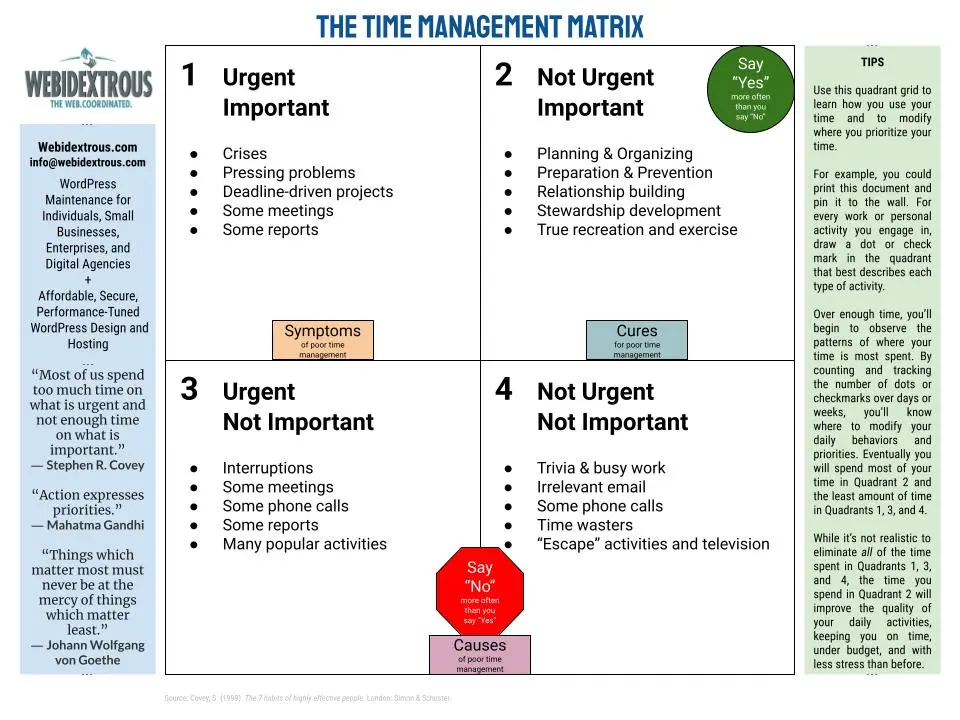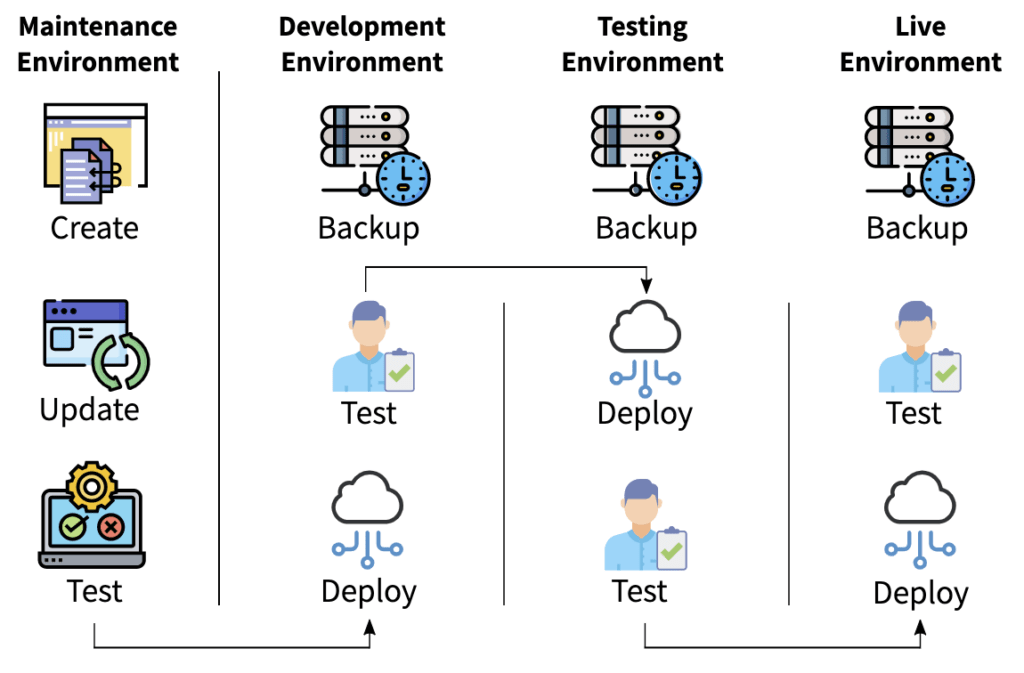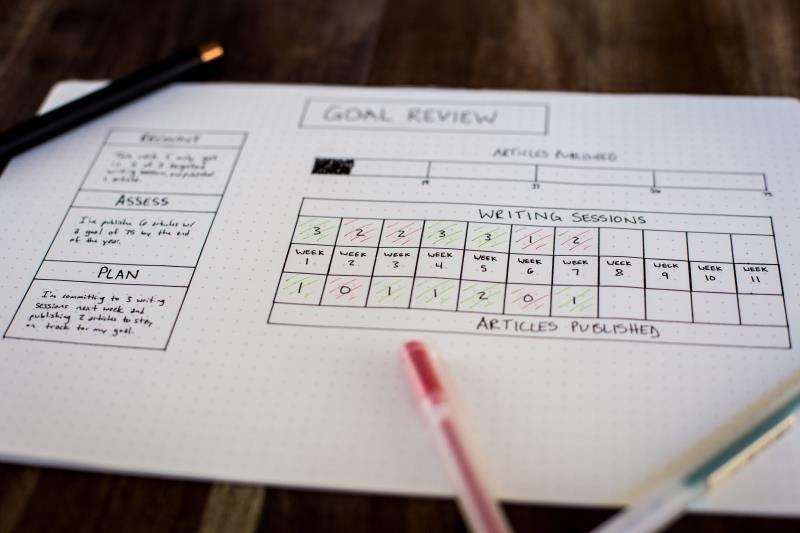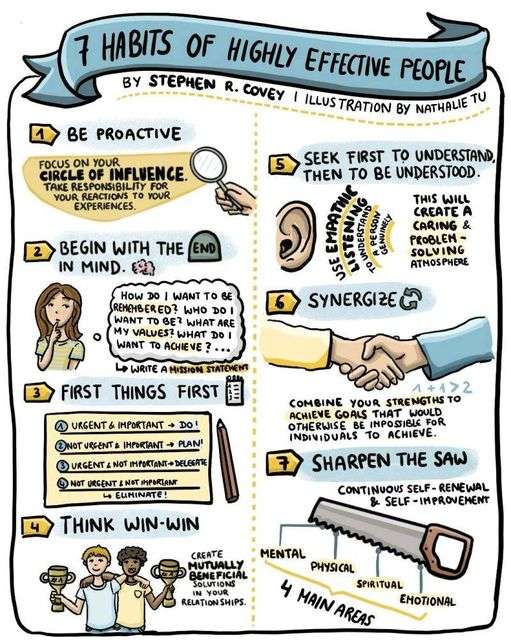Learn how to use the Covey time management matrix to prioritize your day and get your schedule under control.
Sooner or later, all of us succumb to time management frustrations. Keeping our priorities straight is a daily battle, and often a losing battle. It takes perseverance to continually say “no” to distractions. It takes discipline to consistently say “yes” to the things that matter the most, but doing that isn’t as satisfying as putting out fires and looking like a hero. So, we struggle between being active and being productive.
“The main thing is to keep the main thing the main thing.”
Steven R. Covey
Depending on whether you work for a boss or you’re self-employed and you are the boss, your results will vary on another level. If you work for a boss, the temptation is to “look busy” to project an aura of productivity so that you can keep your job. However, if you work for yourself, you have that added pressure of maintaining actual productivity so that you don’t go out of business.
How can you ever truly know whether your efforts are maximized?
Download the Time Management Matrix
You can start with Steven R. Covey’s Time Management Matrix.
The Time Management Matrix divides activities into a grid of four separate quadrants.

The Time Management Matrix quadrants characterize activities by their levels of urgency and importance. At the end of this post, I’ll show you how you can use this worksheet to improve your time management. But, first, you need to know how each time management matrix quadrant relates to the others.
Avoid Quadrants 1, 3, and 4

Quadrants 1, 3 and 4 are the ones we wish to avoid whenever possible. It’s not realistic to think we can always stay out of them, of course, but it’s important to attempt to get out of them as soon as you recognize that you’re in them. They represent different combinations of crisis activities with time wasting activities.
Time Management Matrix Quadrant 1
Quadrant 1 is something you can almost never say “no” to. It often manifests itself as a symptom of the disease of wasted time or of less time spent being better prepared and focused on both short- and longer-term goals. Quadrant 1 in the time management matrix consists of priorities that are both urgent and important. These are the fires you’re trying to put out. They tend to include:
- Crises
- Pressing problems
- Deadline-driven projects
- Some meetings
- Some reports
For example, when someone hacks your website, or your customer service team experiences a spike in activity, those are urgent and important tasks in Quadrant 1.
Time Management Matrix Quadrant 3
We’ll skip Quadrant 2 for a moment (keep reading) and hop to Quadrant 3. In Quadrant 3, tasks are urgent but not important and can include:
- Interruptions
- Some meetings
- Some phone calls
- Some reports
- Many popular activities
For example, a task that is urgent but not important might be someone stopping by unannounced to discuss a website traffic report showing an imminent or recent spike in orders. You can look at it as an early warning to solve for and avoid landing in Quadrant 1. Or, it might be a vendor calling to follow up on a recent bug report you submitted. It’s urgent in that you need to know the details but not important if you’ve already updated the software to fix it.

Gone are the days of clicking “Update” and hoping for the best. Let Webidextrous manage your maintenance. We’ll give you back your time and peace of mind.
Time Management Matrix Quadrant 4
Items that fall into the Quadrant 4 area of not urgent and not important are typically things that can almost always be put off until another time.
- Trivia & busy work
- Irrelevant email
- Some phone calls
- Time wasters
- “Escape” activities and television
These include such things as webinars (just watch the recording some other time) or browsing social media.
Note that Quadrants 3 and 4 tend to be the causes of so much of our productivity loss. They’re the daily interruptions or time wasters that sap our energy and lead us to feel like we got nothing done, even though we were “busy” all day.
You should say “No” to Quadrant 3 and 4 items more often than you say yes. You’re going to be in Quadrant 1 because of stuff in 3 and 4. Because we were so distracted by “activity” that wasn’t productive, we are now in crisis mode, putting out fires that didn’t need to start in the first place.
If only we had a way to plan, prepare, and prevent our way to better results!
Use Quadrant 2 To Be Proactive and Productive

Planning, preparing, and preventing are what Quadrant 2 is all about.
- Planning & Organizing
- Preparation & Prevention
- Relationship building
- Stewardship Development
- True recreation and exercise
This is where we want to spend the majority of our time. Quadrant 2, where everything is not urgent but important, is putting our minds into a proactive rather than a reactive flow. It’s about looking forward, getting organized, planning our work and then working our plan.
Quadrant 2 is the cure for the productivity losses in Quadrants 1, 3, and 4. In this area, we put together strategies, playbooks, project plans, systems for tracking ideas and progress, and relationship-building activities. By doing so, we’re forecasting, estimating, and preventing the situations that can lead to spending too much time in the other quadrants.
How To Use This Worksheet
- If you haven’t already downloaded the worksheet, download it now and print it. I’ll wait. 🙂
- Now, just tack it to your wall, bulletin board, or place it on your desk. The important thing is to ensure that it’s always close at hand and within your field of vision.
- Every time you have a task or meeting, experience an interruption, want to browse social media, or have a fire to put out, figure out what quadrant it belongs in and put a dot or checkmark in that quadrant. That’s all. No need to write the name of the item.
- Do this for several days, or even weeks, and see where the marks accumulate the most.
You’ve now scientifically measured where your efforts are focused and where they are not. If you’re mostly spending time in Quadrant 2, congratulations! You’re being very productive and proactive. However, if you’re spending a lot of time in Quadrants 1, 3, and 4, try to figure out what needs to happen in your workflow and time management to ensure that the causes and symptoms of these drains are addressed.
The Importance of Renewing Recreation and Stewardship Development

Note, also, that Quadrant 2 has at least two activities, recreation/exercise and stewardship development, that we don’t often consider as “productivity” items. Why are they there? And what is the difference between those and the activities in Quadrant 4?
It goes without saying these days that exercise is good for you. Exercise has physiological impacts that go beyond mere weight loss or strength gain. When you exercise, your brain produces endorphins and other compounds that help you refocus your energy. Exercise calms the mind and helps you step away to see the bigger picture. So many helpful ideas and solutions to problems come into my head when I’m out riding the bike trail.
Stewardship development is part of separating our “money-making” activities from our “value-adding” activities. We can’t be productive if our only focus is on profits or growth at the expense of being good stewards.
- We are stewards of our hearts and minds (so, go meditate or pray).
- We are stewards of our environment (so, go pick up some litter).
- We are stewards of our homes (so, go give the kitchen a good scrub).
- We are stewards of our families (so, go give a loved one a hug).
- We are stewards of our spiritual responsibilities towards others (so, go help the homeless).
- We are stewards of our connection to a higher purpose (so, go find that purpose).
If we are not attending to our stewardships, then we’ve truly lost perspective. Save time every day to rebalance yourself mentally and spiritually.

Let me know in the comments how this time management worksheet has helped you.
Related Article
Time Management Tips: 31 Great Comments From 31 People
Rob Watson
Latest posts by Rob Watson (see all)
- Scala Hosting: A Feature-Rich WordPress Hosting Solution with Strong Support and Great Reviews - September 30, 2024
- TikTok: A Persistent Risk for Business Branding and Outreach - July 25, 2024
- SEO Learning Outline: 10+ Tips to Supercharge Your Neglected Websites - March 16, 2024
- What are session cookie hacks and why should WordPress users care? - March 8, 2024
- More effective AI: 5 ways your chatbot could be harming your business - February 17, 2024


this is the most thoroughly explained time matrix so far, thank you.
You’re welcome! I’m glad you like it. Please feel free to share it.